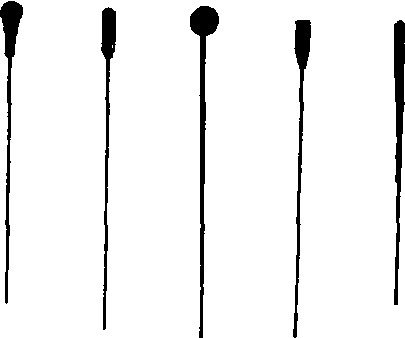指挥棒Zhihuibang
在指挥合唱或合奏时,指挥者手中所执的小棍。制作指挥棒的材料以轻便、富有弹性、不易折断的木质最好,也有用金属、胶木或塑料等材料制作的。指挥棒的式样很多,它由棒尖棒身和棒柄三部分组成。棒柄是被指挥者握在手中的部分。为了便于握牢及保持整个棒体的平衡,一般棒柄要粗一些、重一些,而棒尖是最细的部分。有的指挥棒将棒身涂成白色,或在棒尖装上小型电珠,这都是为便于队员看清指挥动作。指挥棒的长度不同,指挥者可根据自己的身高、臂长以及使用习惯来选择。但一般来讲应以从肘部到伸直的中指尖端的长度较为合适。指挥棒的握法也因各人习惯不同而有所区别。一般握法是将棒柄根部抵住掌心,食指和大指捏住棒柄,中指从旁辅助,也有用中指和食指夹住棒柄握法。但切不可用整个手掌将棒柄握住,因为这样不可能在指挥中轻松、自如地挥棒。另外,握棒方向要和手臂方向一致,使指挥棒起到延长手臂的作用,而不可与手臂形成直角。使用指挥棒有很多优点:❶指挥棒代表了一种至高无上的权威,指挥者执棒会增强其自信心与威严感,队员们必须服从其指挥,精神集中地演奏或演唱。
❷指挥棒的尖端可以更清楚地划出各种不同的指挥线条,表达各种音乐的表情及节奏、强弱、速度,使演奏或演唱协调统一,因此,有人把指挥棒叫“会讲话的小棍”。
❸指挥棒起到延长手臂的作用,可使指挥者顾及到较大范围,在距离指挥较远的地方也能看清指挥的动作,缩短了指挥者与队员之间的距离。然而,也有一些指挥家反对使用指挥棒,其主要理由是:指挥者并不是一个打拍子的工具。在指挥中,指挥者灵活运用双手及每一手指的不同动作、姿态来细致入微地表达出音乐的思想感情,使演奏和演唱更加完美、富于感情表达。这是无生命的指挥棒所无法做到的。总之,是否使用指挥棒可据每个人的习惯而定。一般说来,指挥合唱时,由于队员比较集中,距离指挥也较近,感情表达也需要更细致些,因此,指挥者多采用徒手指挥。而乐
